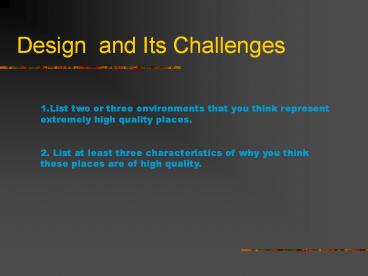Design and Its Challenges - PowerPoint PPT Presentation
1 / 19
Title:
Design and Its Challenges
Description:
Design and Its Challenges 1.List two or three environments that you think represent extremely high quality places. 2. List at least three characteristics of why you ... – PowerPoint PPT presentation
Number of Views:131
Avg rating:3.0/5.0
Title: Design and Its Challenges
1
Design and Its Challenges
1.List two or three environments that you think
represent extremely high quality places. 2. List
at least three characteristics of why you think
these places are of high quality.
2
A Definition of Design
Designing is an activity, aiming at the
production of Plans, which if executed are
expected to lead to a Situation with desired
properties, and without undesired, Unforeseen
side or after effects.
- Design as activity, not a product.
- Aims at something is purposeful.
- Plan as a set of instruction.
3
Styles of Design
Style 1 Routine Behavior
Challenge Resolution
4
Style 2 Trial and Error
Challenge Partial Resolution
Resolution
Yes
No
Feedback
Test
5
A DESIGN PROJECT
6
Style 3 Criteria for Judgment
New challenge
Resolution
Challenge
Alternatives
Feedback
7
A DESIGN PROJECT
8
A DESIGN PROJECT
STYLE III FILTER AT THE END (NO GUARANTEE THAT
ANY SOLUTION PASSES)
9
THE IMAGE
Image subjective knowledge view of the
world Image is what guides our behavior, actions
10
The Knowledge of the Designer
- Factual Knowledge knowledge of how the world
is. - Deontic Knowledge knowledge of what ought to
be. - Explanatory Knowledge knowledge of why
something is. - Instrumental Knowledge how to knowledge.
- Conceptural Knowledge symbols and conventions.
11
Nature of Design Problems
Two Types of Problems/Challenges
a. Tame Challenges 1. Have an exhaustive
definition 2. Ends and Goals well defined 3.
Examples puzzles, math equations, models
b. Wicked Challenges 1. No exhauxtive
definition 2. Formulation same as resolution 3.
Examples social, political, design, and planning
12
Design Challenge Characteristics
- Wicked challenges have no exhaustive
formulation. - The formulation is identical to the resolution.
- Every wicked challenges can be considered a
symptom of - another wicked challenge.
- Wicked challenges have no stopping rules.
- Wicked challenges have many explanations for
discrepancies.
13
Characteristics continued
- Wicked challenges have no test of correctness.
- Wicked challenges have no immediate or
- definitive test of resolution.
- Wicked challenges are one-shot observations.
- Wicked challenges have no list of permissible
- procedures, rules, operations, etc.
- Wicked challenge resolvers have not right to
make an error.
14
VARIABLES
Design Context Performance
15
Variables
- Design Variables- issues under control of the
designer (color, textures, sizes, shape, program
interpretation, visual language) - Context Variables- issues not under control of
the design, owner, or an participant in the
process of designing (cost of materials, climate
zone, geological conditions, regulatory and code
conditions.
16
Variables cont.
- Performance variables- those issues which form
the base for judgments by the designer (level of
safety, aesthetics, level of appropriateness,
efficiency, flexibility) - Pƒ ( d1, d2, d3,.c1, c2, c3, )
17
Scales
Nominal Ordinal Difference Ratio
18
Scales
- Nominal finite, mutually exclusive values that
are unordered ( gas liquid solid,
construction type I, II, III, IV, V, Color
Choice from chart, Height type low-rise
mid-rise high-rise, acceptable unacceptable. - Values do not matter
- Once you make a choice you have only one element
19
Scales cont.
- Ordinal Approximate qualities ( grades -A-F,
hardness - soft to hard, excellence 1-10,
strengths weak-strong) - Difference A continuim of numbers from which
you select a value (Temperature measurement, wind
speed, rainfall, elevations.) - Can not compare elements, but can differences.
- Ratio Used to measure length, weight, volume
(Miles to Kilometers, pounds to kilograms, cubic
feet to cubic meters)

